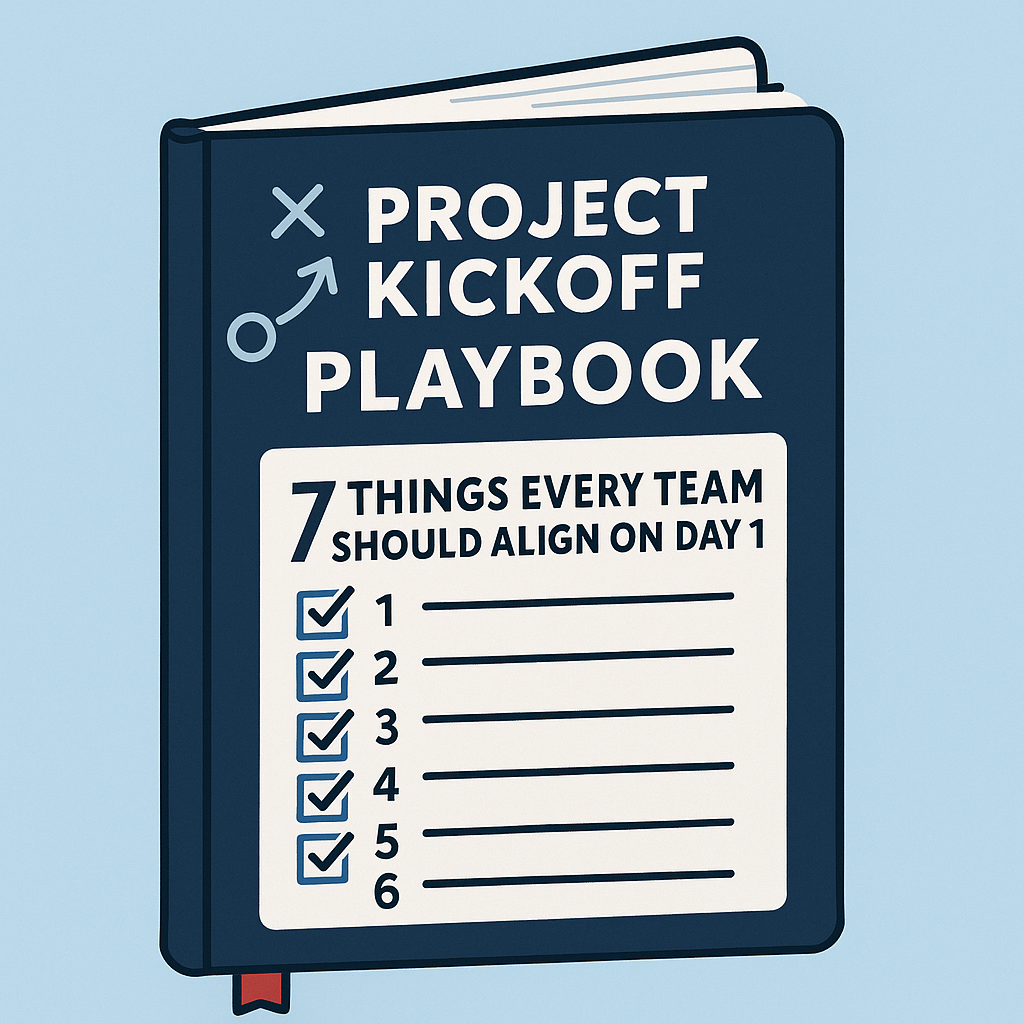
Let’s get one thing straight: most projects don’t fail halfway through. They fail in the first 30 minutes—right there in the kickoff meeting—when everyone nods like they understand what’s happening and walks away with entirely different interpretations.
Kickoffs are not a formality. They’re not a cute team-bonding ritual. They’re a strategic alignment moment. You get one shot to put the project on rails before it barrels off into the woods of “why are we even doing this?”
So here it is. The Project Kickoff Playbook.
Seven things your team needs to align on from Day 1—before anyone drafts a timeline, touches a ticket, or schedules a recurring meeting that no one will show up to.
1. The Problem We’re Actually Solving
Not the feature list. Not the stakeholder wish list. Not whatever someone saw in a competitor’s product last week.
Ask this:
What is the real problem we’re solving, and for whom?
If the answer includes the words “because leadership said so,” you don’t have a project. You have a political timebomb.
Tip: Make everyone write the problem statement in their own words. If the answers don’t match, congratulations—you’ve already identified your first risk.
2. What Success Looks Like (Before the Goalposts Move)
Define success while everyone’s still pretending to be reasonable.
Is it increased adoption? Faster onboarding? Just shipping something by Q4 so it shows up in the OKRs?
Whatever it is, write it down. Be specific. Quantify it. Bonus points if you include what won’t count as success.
Because if you don’t define this up front, the project will magically keep expanding until it’s either “strategic” or “completely off track,” depending on who you ask.
3. Roles, Responsibilities, and Who to Yell At
Titles don’t matter. Clarity does.
Who’s the decision-maker? Who owns delivery? Who’s just there to make noise and forward emails?
Use RACI. Or DACI. Or just a shared doc that says:
“If X breaks, talk to Y. If Y blames Z, you know they’re lying.”
Without this, you’ll spend half the project figuring out who was supposed to do what last week. Check out our previous posts!
4. The Plan (No, Not the Polished One in Slides)
The deck is not the plan. The real plan includes:
Don’t aim for perfection. Aim for shared understanding. If the timeline is made of guesses and hope, just say so. People respect honesty more than “optimistic assumptions.”
5. The Tools You’re Actually Using
Jira? Asana? Notion? Google Sheets and duct tape?
Pick your stack and stick to it.
Document it. Share it. Burn all others.
Because nothing destroys project flow faster than three task lists, two Slack threads, and someone saying “I think that’s in the other board.”
One place for tasks. One place for updates. One source of truth. That’s it.
6. How You’re Communicating (and How Often)
Set the cadence up front. Standups? Weekly status? Async check-ins?
Define:
Also clarify what not to do. (E.g., don’t drop blockers into a Teams message at 5pm Friday and call it “visibility.”)
Silence isn’t efficiency. It’s a liability.
7. What’s Going to Blow This Up (aka the Risk Reality Check)
This is the part where everyone pretends everything’s fine. Don’t let them.
Ask:
What’s the most likely thing to derail this project?
Tech debt? Resource gaps? A VP who loves surprise changes?
Bring it up now, while there’s still time to do something about it. Risk planning is not pessimism—it’s grown-up project management.
Closing Thoughts
If your team can’t align on these seven things by Day 1, cancel the kickoff and try again. It’s cheaper than rework, faster than damage control, and significantly less painful than delivering the wrong thing, late, to the wrong people.
These are all important aspects for a project team to align on and align early. I’ve joined teams where everything is in a silo, no one knows what is happening or who is supposed to even be doing what. The right people aren’t included until it’s too late and there is “No Scope, No Hope”. As much as I’d like to say you can always recover, sometimes the team cannot. Sometimes, things are just too far gone. And that’s when the tough conversations come. The “should we continue this” continue this? Is this all sunk cost? What can we salvage and does it even make sense to?
Project kickoffs aren’t just about optimism and coffee. They’re your last, best chance to make sure everyone’s building the same thing—for the same reason—with the same definition of done.
Bonus: Want This as a Downloadable Kickoff Checklist?
I’ve got a stripped-down version of this playbook I use with clients before every engagement. Message me if you want a copy — or better yet, if you want me to run your kickoff properly so you don’t have to.